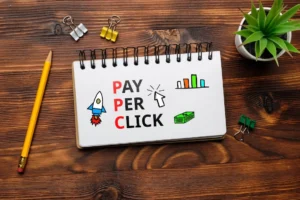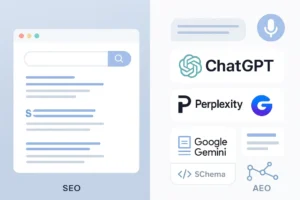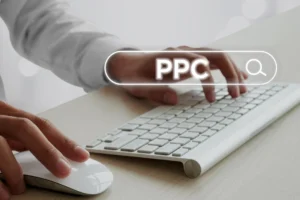Key PPC Terms Defined
Understanding PPC (Pay-Per-Click) advertising can seem complicated with all its unique terms. This guide simplifies common jargon to help you feel more confident.
CTR (Click-Through Rate)
The percentage of people who see your ad and then click on it. It’s calculated by dividing the number of clicks your ad receives by the number of times your ad is shown (impressions).
A higher CTR generally means your ads are relevant and engaging to your target audience. It can also improve your Quality Score, potentially lowering your costs.
CPC (Cost Per Click)
The actual price you pay for each click in your pay-per-click marketing campaigns.
Lowering your CPC means you’re getting more clicks for the same budget, increasing potential traffic and conversions.
CPM (Cost Per Mille/Thousand Impressions)
The cost you pay for one thousand views or impressions of your ad. This is often used for display and branding campaigns.
CPM is useful for measuring the cost-effectiveness of reaching a large audience with your message.
Conversion
A desired action that you want visitors to take on your website, such as filling out a form, making a purchase, or signing up for a newsletter.
Conversions are the ultimate goal of many PPC campaigns. Tracking and improving your conversion rate is crucial for ROI.
Conversion Rate
The percentage of visitors to your website or landing page who complete a desired action (a conversion) out of the total number of visitors.
A higher conversion rate means your website or landing page is effective at persuading visitors to take the desired action.
Impressions
Each time your ad is displayed to a user. This doesn’t mean the user clicked on the ad, just that it was shown.
Impressions are important for brand awareness. A high number of impressions means your ad is being seen by a lot of people.
Quality Score
A rating given by Google to the quality and relevance of your keywords, ads, and landing pages. A higher Quality Score can lead to lower costs and better ad positions.
Improving your Quality Score is essential for maximizing the efficiency and effectiveness of your PPC campaigns.
Landing Page
The specific webpage a user arrives at after clicking on your ad. It should be relevant to the ad’s message and designed to encourage conversions.
A well-optimized landing page is crucial for converting ad clicks into desired actions.
Keywords
The words or phrases that you bid on in your PPC campaigns. These are the terms people are likely to search for on search engines.
Choosing the right keywords is fundamental to reaching the right audience with your ads.
Ad Rank
A value that’s used to determine your ad position. It’s calculated based on your bid amount, Quality Score, and the expected impact of extensions and other ad formats.
A higher Ad Rank means your ad is more likely to appear in a prominent position on the search results page.
Understanding these terms is a great first step in grasping the fundamentals of PPC advertising. We’re here to help you navigate the complexities and achieve your marketing goals.
ROAS (Return on Ad Spend)
A metric that measures the revenue generated for every dollar spent on advertising.
Formula: Revenue ÷ Ad Spend.
Understanding ROAS helps you determine the profitability of your campaigns.
CPA (Cost Per Acquisition/Action)
The cost of acquiring a customer or getting a user to perform a specific action, such as filling out a form or making a purchase.
Formula: Total Ad Spend ÷ Total Conversions.
Tracking CPA ensures your campaigns stay cost-effective.
LSA (Local Services Ads)
A type of ad format for local businesses that appears at the top of Google search results, often with a “Google Guaranteed” badge.
Ideal for location-based businesses like law firms looking to build trust and generate local leads.
Negative Keywords
Keywords you exclude from your campaigns to prevent your ads from appearing in irrelevant searches.
Using negative keywords can help improve CTR and reduce wasted ad spend.
Impression Share
The percentage of total impressions your ad receives compared to the total available impressions.
A higher impression share indicates strong visibility in your market.
Bid Strategy
The method you use to set bids in PPC campaigns, such as manual bidding or automated bidding (e.g., Target CPA, Maximize Clicks, or ROAS).
Choosing the right strategy can impact cost efficiency and campaign performance.
Ad Extensions
Additional information displayed alongside your ad, such as callouts, sitelinks, or phone numbers.
Using ad extensions can improve CTR and provide more value to users.
Remarketing/Retargeting
A strategy to show ads to people who’ve already visited your website or engaged with your content.
Remarketing is effective for re-engaging users and boosting conversions.
Geo-Targeting
Targeting ads to specific geographic locations, such as cities, regions, or countries.
Geo-targeting helps focus ad spend where your audience is located.
Call-to-Action (CTA)
The directive in your ad encouraging users to take a specific action, such as “Call Now” or “Sign Up Today.”
A strong CTA improves click-through and conversion rates.
Display Network
A network of websites, videos, and apps where your display ads can appear.
It’s useful for increasing brand awareness and reaching a broader audience.
A/B Testing
Testing two versions of an ad, landing page, or campaign element to see which performs better.
Ongoing A/B testing can help optimize your PPC campaigns.











